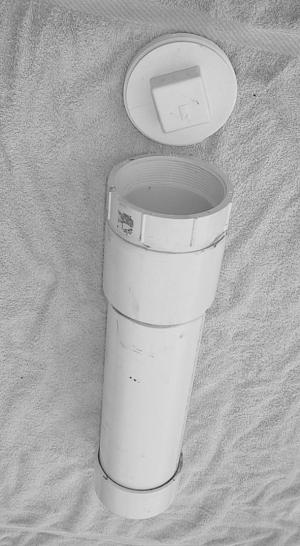2004 - Volume #28, Issue #3, Page #31
[ Sample Stories From This Issue | List of All Stories In This Issue | Print this story
| Read this issue]
Simple Safe Protects Valuables
 |
"Most inexpensive personal safes sold today have warnings in small print stating that during a fire they cannot protect computer disks," says Yago, an engineer and author.
Even without the risk to electronic data, small personal safes can be at risk of being carried away by floods, tornadoes or intruders. Yago's idea is to make a safe out of watertight pvc pipe, and then bury it.
"Purchase the heavier wall, Schedule 40 pvc piping," says Yago. "You can make it any length to match whatever you want to protect."
Yago prefers 2 to 3-ft. lengths and at least a 3 to 6-in. diameter. He also recommends using Oatey brand purple pvc primer cleaners and allūpurpose cement. He suggests using new primer cleaners and cement as both tend to deteriorate once opened.
"Use a hacksaw or handsaw to cut the pipe to length with ends straight and square for a good fit," advises Yago. "Remove any burrs or rough edges, then apply the primer to outside surfaces near one end of the pipe and inside the lip of the pipe cap."
The primer softens the surfaces prior to gluing. Once the primer begins to dry, you apply the cement to the exterior surface to be capped.
After inserting documents and other items for safekeeping, he recommends inserting an 8-oz. bag of silica gel to absorb any moisture sealed inside the pipe. Without it, that moisture may condense on the pipe wall and damage documents.
Yago notes that used gel packs can be reused after slowly heating them in an oven at low temperatures.
Once completed, the final step is concealment. How deep such a safe should be buried depends on the frost line, when or how often it will be retrieved, and what is stored inside.
"Filling the hole with sand after digging it will make it easier to access on a regular basis, but also easier for others to notice," advises Yago. "For extreme fire, explosion and flood protection, 36 in. deep is best. It's also below the working depth of most farm and construction machinery." Yogo is also author of a book called Achieving Energy Independence ū One Step At A Time, which provides a very good introduction to off-grid living and battery-based power systems. It is available by calling 804 457-9566.
Contact: FARM SHOW Followup, Jeff Yago, J.R. Yago & Assoc., P.O. Box 10, Gum Spring, Va. 23065 (ph 804 457-2113; email: jryago@wwjv.net).

Click here to download page story appeared in.

Click here to read entire issue
To read the rest of this story, download this issue below or click here to register with your account number.




